Patty and Robert are getting some books from their local library. They find a large pile of books, and decide to play a giant game of Jenga. Suppose that all the books have a mass \(m_b\) and the coefficient of kinetic friction between the covers of all the books is \(\mu_k\). Also suppose that the book at the bottom never moves.
(a) Draw the force diagram of the top four books in the case where Patty starts pulling the book with some constant force \(F\) and Robert is not exerting any force yet.
(b) If Patty and Robert are both pulling the books in opposite directions and with the same constant force \(F\), in what direction will the third book (from top to bottom) move?
a) Start with the books where a force is applied, then the friction of each book will oppose to the possible movement. And for the other books, the friction will be on the opposite side by Newton’s third law.
b) Evaluate the possible cases with the equation obtained for the book. Considering the magnitude of the normal forces, you will find the answer.
a) The first book:
The second book:
The third book:
The fourth book:
b) The equation that relates the forces acting on the third book along the \({x-}\)axis is:
\begin{equation*}
-f_{r_p} + f_{r_r} = m a.
\end{equation*}
To determine which force is greater in magnitude, \(f_{r_p}\) or \(f_{r_r}\), remember that the friction force is given by \(\mu N\), so it depends on \(N\). This means that \(N\) must be greater for the books stacked at the bottom compared to the books stacked toward the top. Since \(\mu\) is the same for all books, \(f_{r_r}\) must be greater than \(f_{r_p}\), so the acceleration of the third book will be positive (towards the right).
For a more detailed explanation of any of these steps, click on “Detailed Solution”.
a) Patty is pulling the book while Robert has not yet begun to exert any force over the book he wants to pull out. In order to draw the force diagram, let’s use a coordinate system (see figure 1) with the positive direction of X pointing to the right and the positive Y direction pointing upwards.
Figure 1: We choose the coordinate system with X along the horizontal and Y along the vertical.
Three horizontal forces act over the book Patty is pulling. The force \(F\) acts in the negative direction of X, and two forces of friction exerted by the upper and lower books act in the opposite direction (opposing the motion of Patty’s book). Along the vertical direction, there are three forces: the weight, and the two normal forces produced by the covers of the upper and lower book (the upper book exerts a normal force in the negative direction of Y, and the lower book exerts a normal force along the positive Y direction). Thus, for Patty’s book, we have the force diagram in figure 2.
Figure 2: Force diagram for Patty’s book. The forces depicted are: the weight of the book \(W_2\), the contact force from the book below \(N_2\), the contact force from the book above \(N_3\), the friction force exerted by the book below \(f_r2\), the friction force exerted by the book above \(f_r3\), and the force exerted by Patty \(F_P\).
Over the book on the top, there is only one force acting on the X direction, namely, the force of friction that Patty’s book exerts on it. We already saw that the top book exerts a force of friction over Patty’s book along the positive X direction. Thus, by Newton’s Third Law, Patty’s book must exert a force of friction over the top book in the opposite direction (the negative X direction). Another way of seeing this is by noticing that, from the point of view of the upper book, Patty’s book tries to drag it in the direction it moves (it moves in the negative X direction). Along the Y axis, there are two forces over the top book. Its weight, pointing downwards, and the normal force exerted by Patty’s book, which points upwards. The force diagram can be found in figure 3.
Figure 3: Force diagram for the book on top. The forces presented are: the weight \(W_1\), the friction \(f_{r1}\) and the contact force \(N_1\).
Notice that while Patty pulls her book out, that book tries to drag the third book (from top to bottom) in the negative X direction. Thus, the third book must feel a force of friction in the negative X direction (another way of seeing this is the following one: the third book exerts a friction force over Patty’s book along the positive X axis, and so by Newton’s Third Law, Patty’s book must exert a force over the third book in the negative X direction). But Robert’s book also exerts a friction force over the third book. Since the third book tends to move in the negative X direction (due to Patty’s book), then Robert’s book will exert a force of friction in the positive X direction (a force that makes it harder for the third book to move). In the Y direction, there are three forces acting over the third book: its weight, in the negative Y direction, and the normal forces produced by Patty’s and Robert’s books. Patty’s book exerts a normal force over the third book in the negative Y direction, while Robert’s book exerts a normal force over the third book in the positive Y direction. The force diagram is thus found in figure 4.
Figure 4: Force diagram for the third book. The forces depicted are: the weight of the book \(W_3\), the contact force from the book below \(N_4\), the contact force from the book above \(N_5\), the friction force exerted by the book below \(f_{r4}\), and the friction force exerted by the book above \(f_{r5}\).
For Robert’s book, we find two horizontal forces. Recall that the third book will tend to move in the negative X direction (due to Patty’s book, which drags it). Thus, the third book will tend to move Robert’s book along the negative X direction as well; thus, the friction exerted by the third book on Robert’s book is in the negative X direction (another way of seeing this: Robert’s book exerted a friction over the third book in the positive X direction, and so by Newton’s Third Law, the third book will exert a friction force in the negative X direction). But while the third book tends to drag Robert’s book in the negative X direction, the book at the bottom of the stack (the blue one) will try to oppose that motion and, consequently, will exert a force of friction over Robert’s book that goes in the positive X direction. Finally, along Y, we find, again, two normal forces (one exerted by the third book, pointing downwards, and one exerted by the book at the bottom, pointing upwards) and the weight (pointing downwards). Thus, the force diagram is shown in figure 5.
Figure 5: Force diagram for Robert’s book. The forces depicted are: the weight of the book \(W_4\), the contact force from the book below \(N_6\), the contact force from the book above \(N_7\), the friction force exerted by the book below \(f_{r6}\), the friction force exerted by the book above \(f_{r7}\) and the force exerted by Robert \(F_R\).
b) In order to figure out in what direction will the third book move, let’s write the equation of forces for the third book along X. Notice that Patty’s book will exert a friction force in the negative X-direction, while Robert’s book will exert a friction force in the positive X-direction:
\begin{equation}
-f_{r_p} \, \hat{\textbf{i}} + f_{r_r} \, \hat{\textbf{i}} = m a \, \hat{\textbf{i}}
\end{equation}
The question then comes down to this: Is the acceleration positive or negative? Equivalently: Which one is greater, \(f_{r_p}\) or \(f_{r_r}\)? Well, the force of kinetic friction is given by \(\mu N\), so now let’s try to find \(N\) for these two friction forces. In one case, \(N\) is the normal force that Patty’s book exerts on the third book, and in the other case, \(N\) is the normal force that Robert’s book exerts on the third book.
But we don’t need to compute anything because it is clear \(N\) is greater for the books at the bottom, because \(N\) is proportional to the weight of the other objects on top of the book (the more objects on top, the greater the pressure and so the stronger the contact force between surfaces). Since \(\mu\) is the same for all books, and since the \(N\) produced by Robert’s book is greater than the \(N\) produced by Patty’s book, then we infer that the friction due to Robert’s book is greater than the friction due to Patty’s book. Thus, \(f_{r_r}\) is greater than \(f_{r_p}\), and so the acceleration of the third book will be positive (towards the right).
You need to be registered and logged in to take this quiz. Log in

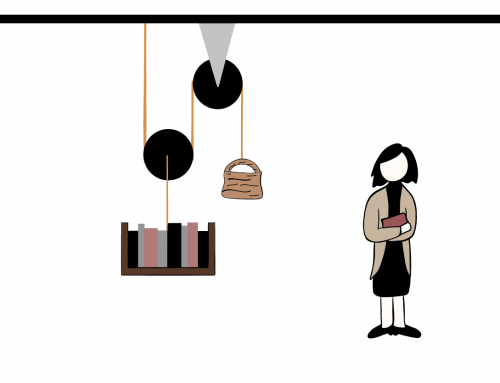
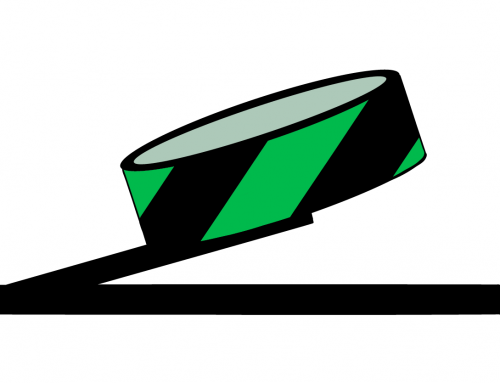
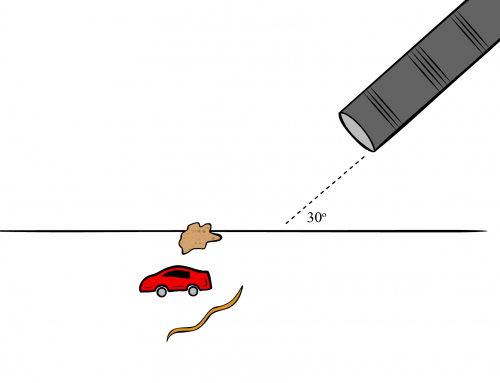
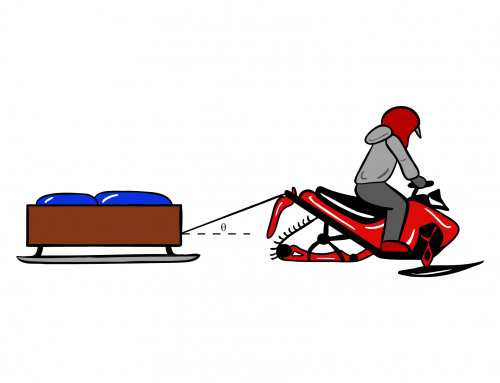
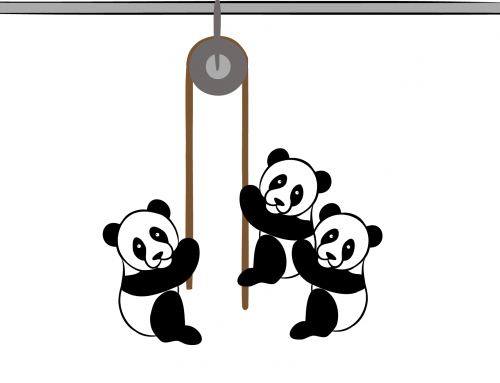
a very nice problem, you have to think about the differents forces that are in this situation, and are very well explained the exercises